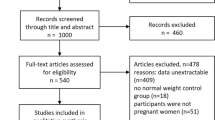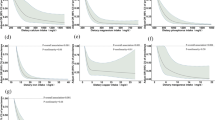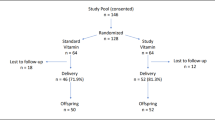Abstract
Evidence suggests selenium concentrations outside the nutritional range may worsen cardiovascular health. This paper examines the relationship between selenium and maternal blood pressure (BP) among 270 deliveries using umbilical cord serum as a proxy for maternal exposure levels. Multivariable models used linear splines for selenium and controlled for gestational age, maternal age, race, median household income, parity, smoking, and prepregnancy body mass index. Non-parametric analysis of this dataset was used to select spline knots for selenium at 70 and 90 μg/l. When selenium was <70 μg/l, increasing selenium levels were related to a non-statistically significant decrease in BP. For selenium 70–90 μg/l, a 1 μg/l increase was related to a 0.37 mm Hg (95% confidence interval (CI): 0.005, 0.73) change in systolic and a 0.35 mm Hg (0.07, 0.64) change in diastolic BP. There were very few selenium values >90 μg/l. Other studies indicate that the maternal/cord selenium ratio is 1.46 (95% CI: 1.28, 1.65). This u-shaped relationship between selenium and BP is consistent with a dual role of selenium as an essential micronutrient that is nonetheless a toxicant at higher concentrations; however, this needs to be studied further.
This is a preview of subscription content, access via your institution
Access options
Subscribe to this journal
Receive 6 print issues and online access
$259.00 per year
only $43.17 per issue
Buy this article
- Purchase on Springer Link
- Instant access to full article PDF
Prices may be subject to local taxes which are calculated during checkout

Similar content being viewed by others
References
Apelberg B.J., Goldman L.R., Calafat A.M., Herbstman J.B., Kuklenyik Z., and Heidler J., et al. Determinants of fetal exposure to polyfluoroalkyl compounds in Baltimore, Maryland. Environ Sci Technol 2007: 41 (11): 3891–3897.
Bernert Jr J.T., Turner W.E., Pirkle J.L., Sosnoff C.S., Akins J.R., and Waldrep M.K., et al. Development and validation of sensitive method for determination of serum cotinine in smokers and nonsmokers by liquid chromatography/atmospheric pressure ionization tandem mass spectrometry. Clin Chem 1997: 43 (12): 2281–2291.
Bleys J., Navas-Acien A., and Guallar E. Serum selenium levels and all-cause, cancer, and cardiovascular mortality among US adults. Arch Intern Med 2008: 168 (4): 404–410.
Broadley M.R., White P.J., Bryson R.J., Meacham M.C., Bowen H.C., and Johnson S.E., et al. Biofortification of UK food crops with selenium. Proc Nutr Soc 2006: 65 (2): 169–181.
Brown K.M., and Arthur J.R. Selenium, selenoproteins and human health: a review. Public Health Nutr 2001: 4 (2B): 593–599.
Butler Walker J., Houseman J., Seddon L., McMullen E., Tofflemire K., and Mills C., et al. Maternal and umbilical cord blood levels of mercury, lead, cadmium, and essential trace elements in Arctic Canada. Environ Res 2006: 100 (3): 295–318.
Combs Jr G.F. Selenium in global food systems. Br J Nutr 2001: 85 (5): 517–547.
Dawson E.B., Albers J.H., and McGanity W.J. The apparent effect of iron supplementation on serum selenium levels in teenage pregnancy. Biol Trace Elem Res 2000: 77 (3): 209–217.
Flores-Mateo G., Navas-Acien A., Pastor-Barriuso R., and Guallar E. Selenium and coronary heart disease: a meta-analysis. Am J Clin Nutr 2006: 84 (4): 762–773.
Han L., and Zhou S.M. Selenium supplement in the prevention of pregnancy induced hypertension. Chin Med J (Engl) 1994: 107 (11): 870–871.
Institute of Medicine. Dietary Reference Intakes for Vitamin C, Vitamin E, Selenium, and Carotenoids. National Academy Press, Washington, DC, 2000.
Jossa F., Trevisan M., Krogh V., Farinaro E., Giumetti D., and Fusco G., et al. Serum selenium and coronary heart disease risk factors in southern Italian men. Atherosclerosis 1991: 87 (2–3): 129–134.
Kaaja R.J., and Greer I.A. Manifestations of chronic disease during pregnancy. JAMA 2005: 294 (21): 2751–2757.
Kantola M., Purkunen R., Kroger P., Tooming A., Juravskaja J., and Pasanen M., et al. Selenium in pregnancy: is selenium an active defective ion against environmental chemical stress? Environ Res 2004: 96 (1): 51–61.
Laclaustra M., Navas-Acien A., Stranges S., Ordovas J.M., and Guallar E. Serum selenium concentrations and hypertension in the US population. Circ Cardiovasc Qual Outcomes 2009: 2 (4): 369–376.
Lorenzo Alonso M.J., Bermejo Barrera A., Cocho de Juan J.A., Fraga Bermudez J.M., and Bermejo Barrera P. Selenium levels in related biological samples: human placenta, maternal and umbilical cord blood, hair and nails. J Trace Elem Med Biol 2005: 19 (1): 49–54.
Lykke J.A., Langhoff-Roos J., Sibai B.M., Funai E.F., Triche E.W., and Paidas M.J. Hypertensive pregnancy disorders and subsequent cardiovascular morbidity and type 2 diabetes mellitus in the mother. Hypertension 2009: 53 (6): 944–951.
Mahomed K., Williams M.A., Woelk G.B., Mudzamiri S., Madzime S., and King I.B., et al. Leukocyte selenium, zinc, and copper concentrations in preeclamptic and normotensive pregnant women. Biol Trace Elem Res 2000: 75 (1–3): 107–118.
Makhoul I.R., Sammour R.N., Diamond E., Shohat I., Tamir A., and Shamir R. Selenium concentrations in maternal and umbilical cord blood at 24–42 weeks of gestation: basis for optimization of selenium supplementation to premature infants. Clin Nutr 2004: 23 (3): 373–381.
Micetic-Turk D., Rossipal E., Krachler M., and Li F. Maternal selenium status in Slovenia and its impact on the selenium concentration of umbilical cord serum and colostrum. Eur J Clin Nutr 2000: 54 (6): 522–524.
Mistry H.D., Wilson V., Ramsay M.M., Symonds M.E., and Broughton Pipkin F. Reduced selenium concentrations and glutathione peroxidase activity in preeclamptic pregnancies. Hypertension 2008: 52 (5): 881–888.
Navarro M., Lopez H., Perez V., and Lopez M.C. Serum selenium levels during normal pregnancy in healthy Spanish women. Sci Total Environ 1996: 186 (3): 237–242.
Navas-Acien A., Bleys J., and Guallar E. Selenium intake and cardiovascular risk: what is new? Curr Opin Lipidol 2008: 19 (1): 43–49.
Nawrot T.S., Staessen J.A., Roels H.A., Den Hond E., Thijs L., and Fagard R.H., et al. Blood pressure and blood selenium: a cross-sectional and longitudinal population study. Eur Heart J 2007: 28 (5): 628–633.
Osman K., Akesson A., Berglund M., Bremme K., Schutz A., and Ask K., et al. Toxic and essential elements in placentas of Swedish women. Clin Biochem 2000: 33 (2): 131–138.
Rayman M.P. Food-chain selenium and human health: emphasis on intake. Br J Nutr 2008: 100 (2): 254–268.
Rayman M.P., Bode P., and Redman C.W. Low selenium status is associated with the occurrence of the pregnancy disease preeclampsia in women from the United Kingdom. Am J Obstet Gynecol 2003: 189 (5): 1343–1349.
Rudge C.V., Rollin H.B., Nogueira C.M., Thomassen Y., Rudge M.C., and Odland J.O. The placenta as a barrier for toxic and essential elements in paired maternal and cord blood samples of South African delivering women. J Environ Monit 2009: 11 (7): 1322–1330.
Sakamoto M., Murata K., Kubota M., Nakai K., and Satoh H. Mercury and heavy metal profiles of maternal and umbilical cord RBCs in Japanese population. Ecotoxicol Environ Saf 2010: 73 (1): 1–6.
Schulpis K.H., Karakonstantakis T., Gavrili S., Chronopoulou G., Karikas G.A., and Vlachos G., et al. Maternal — neonatal serum selenium and copper levels in Greeks and Albanians. Eur J Clin Nutr 2004: 58 (9): 1314–1318.
Stranges S., Navas-Acien A., Rayman M.P., and Guallar E. Selenium status and cardiometabolic health: state of the evidence. Nutr Metab Cardiovasc Dis 2010: 20 (10): 754–760.
Suadicani P., Hein H.O., and Gyntelberg F. Serum selenium concentration and risk of ischaemic heart disease in a prospective cohort study of 3000 males. Atherosclerosis 1992: 96 (1): 33–42.
Taittonen L., Nuutinen M., Rasanen L., Mussalo-Rauhamaa H., Turtinen J., and Uhari M. Lack of association between copper, zinc, selenium and blood pressure among healthy children. J Hum Hypertens 1997: 11 (7): 429–433.
Tara F., Maamouri G., Rayman M.P., Ghayour-Mobarhan M., Sahebkar A., and Yazarlu O., et al. Selenium supplementation and the incidence of preeclampsia in pregnant Iranian women: a randomized, double-blind, placebo-controlled pilot trial. Taiwan J Obstet Gynecol 2010: 49 (2): 181–187.
US Centers for Disease Control and Prevention (CDC). Third National Report on Human Exposure to Environmental Chemicals. CDC, Atlanta, (GA), 2005.
Wasowicz W., Wolkanin P., Bednarski M., Gromadzinska J., Sklodowska M., and Grzybowska K. Plasma trace element (Se, Zn, Cu) concentrations in maternal and umbilical cord blood in Poland. Relation with birth weight, gestational age, and parity. Biol Trace Elem Res 1993: 38 (2): 205–215.
Witter F.R., Ten Broeck J., and Fox H.E. A new device for safer collection of postpartum cord blood. Int J Gynaecol Obstet 2001: 72 (3): 259–260.
Xiao G. Zinc, Copper and Selenium in Serum by ICP-DRC-MS (ICPDRCMS-3006.1). Centers for Disease Control and Prevention, Atlanta, GA, 2006.
Acknowledgements
We thank Drs. John Bernert, Jochen Heidler, Joseph Hibbeln, Robert Jones, and Norman Salem, Jr. for contributing to data collection; Drs. Ana Navas-Acien and Ellen Silbergeld for advice; and Ruth Quinn and Tonya Shephard for project support. This work was supported in part by the Maryland Cigarette Restitution Program Research Grant, National Institute of Environmental Health Sciences grant 1R01ES015445 (RUH), and a United States Environmental Protection Agency Science to Achieve Results (STAR) Fellowship (EMW). The content and views presented in this work are solely the responsibility of the authors and do not necessarily represent those of US EPA, CDC, or NIH.
Author information
Authors and Affiliations
Corresponding author
Ethics declarations
Competing interests
The authors declare no conflict of interest.
Additional information
Supplementary Information accompanies the paper on the Journal of Exposure Science and Environmental Epidemiology website
Supplementary information
Rights and permissions
About this article
Cite this article
Wells, E., Goldman, L., Jarrett, J. et al. Selenium and maternal blood pressure during childbirth. J Expo Sci Environ Epidemiol 22, 191–197 (2012). https://doi.org/10.1038/jes.2011.42
Received:
Accepted:
Published:
Issue Date:
DOI: https://doi.org/10.1038/jes.2011.42
Keywords
This article is cited by
-
Coexposure to Multiple Metals and the Risk of Abnormal Blood Pressure in Chinese Children
Exposure and Health (2024)
-
Prenatal metal mixtures and child blood pressure in the Rhea mother-child cohort in Greece
Environmental Health (2021)



